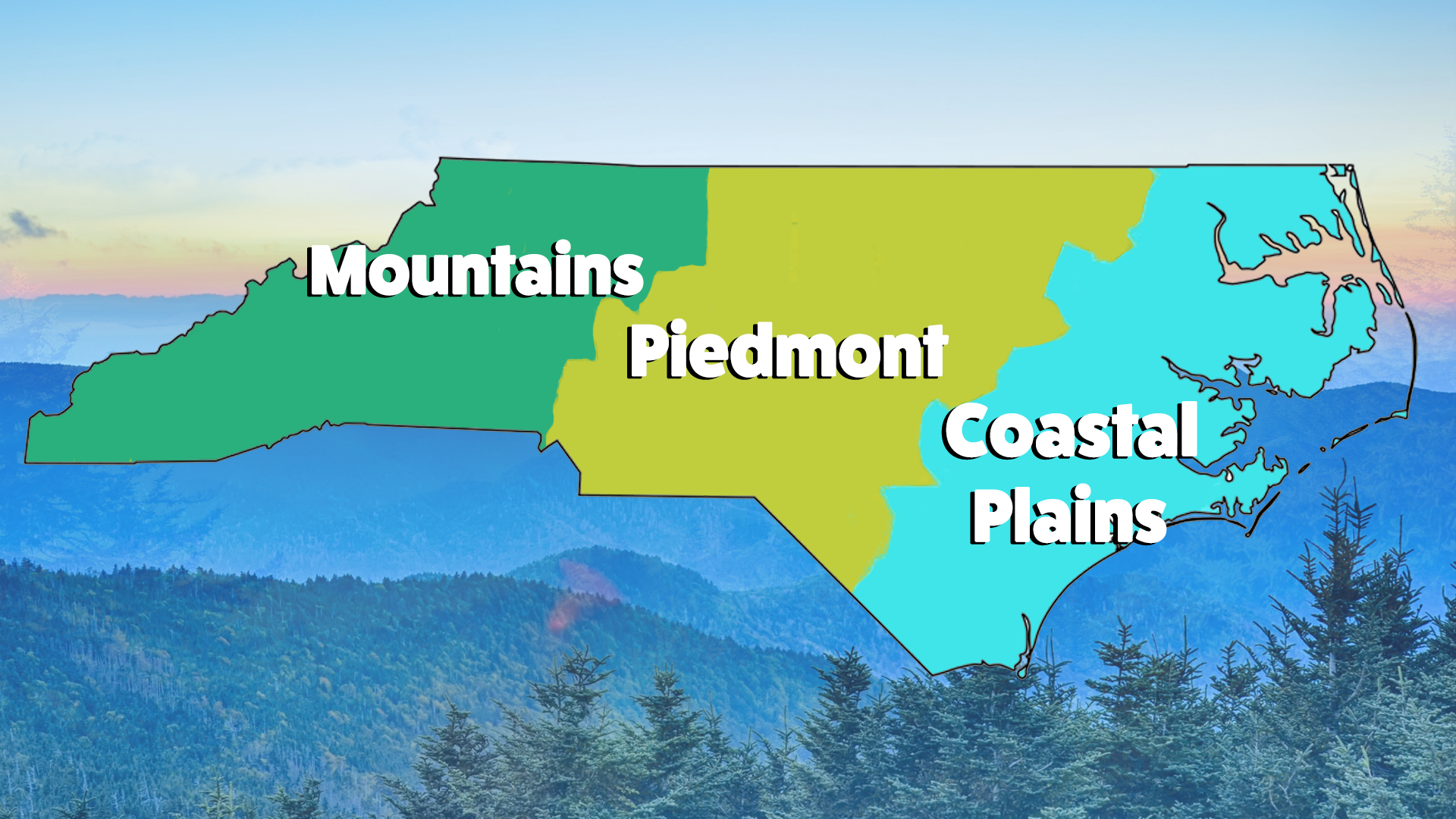North Carolina’s Three Regions: Mountains, Piedmont, and Coastal Plain

North Carolina is a state of contrasts: rugged mountains in the west, rolling hills in the center, and wide coastal plains in the east.
The Dive
In North Carolina, the Mountains, Piedmont, and Coastal Plain created distinct environments that shaped how people lived, worked, and connected with one another. Each region offered different opportunities and challenges, influencing settlement patterns and cultural identities in ways that still echo today.
The Mountain region in the west, home to the Blue Ridge and Smoky Mountains, offered natural protection and relative isolation. Early settlers often lived in small, close-knit communities where farming was difficult but self-reliance and tradition thrived. This isolation helped preserve folk music, crafts, and storytelling traditions that remain central to Appalachian culture today.
The Piedmont plateau, stretching across the center of the state, became a hub of farming, trade, and eventually industry. Its rolling hills and fertile soil made it ideal for small farms, while rivers provided power for early mills. Later, the Piedmont became known for textiles, furniture, and tobacco, shaping its identity as an industrial heartland. Its location also made it a crossroads between the coast and the mountains.
The Coastal Plain, stretching eastward to the Atlantic Ocean, offered fertile farmland and easy access to trade routes. Port cities like Wilmington and New Bern became centers of commerce, where ships carried goods to and from Europe and the Caribbean. But the coast also posed risks: hurricanes, shifting barrier islands, and marshlands made settlement challenging. Communities here often relied on fishing, naval stores, and farming.
These regions weren’t isolated from each other—they were interdependent. Coastal ports connected mountain farmers to global trade, while Piedmont towns grew into centers of government and education that served the whole state. Differences in climate, soil, and access to resources meant that each region contributed something unique to North Carolina’s identity.
Climate also shaped life in each region. While the mountains faced colder winters and shorter growing seasons, the Coastal Plain enjoyed long, hot summers that allowed for crops like rice and cotton. The Piedmont, somewhere in between, benefited from a moderate climate that supported a mix of agriculture and industry. These variations helped diversify the state’s economy.
Culturally, living in the mountains fostered resilience and independence, while coastal communities grew cosmopolitan through trade. The Piedmont developed a spirit of innovation and pragmatism, balancing the influences of both. Taken together, the three regions reflect how environment and culture constantly interact, shaping both the challenges people face and the solutions they create.
Why It Matters
Geography shapes how people live, from the food they grow to the culture they create. By studying North Carolina’s three regions, we can see how the land itself influences history, economy, and community identity. Understanding these patterns builds a deeper appreciation of how humans and environments are interconnected.
?
How did geography shape settlement patterns in North Carolina’s three regions?
How did port cities on the coast shape the North Carolina's connections to global trade?
Why did the Piedmont become an industrial hub compared to the Coastal Plain or Mountains?
What cultural traditions from the Appalachian Mountains continue to influence North Carolina today?
In what ways do climate differences across the regions of North Carolina continue to affect communities today?
Dig Deeper
North Carolina and South Carolina began as one colony. This video explores how politics and geography shaped their division into two distinct states.
The First Appalachians were Scotch Irish and arrived in Appalachia with their love for God, Guns, and Liquor. These Appalachians survived in the Appalachian Mountains because of their Appalachian customs, traditions, and help from nature. The Chestnut tree, moonshine and the primitive baptist church were vital to their survival.
The North Carolina Piedmont is the central geographical region of the state, situated between the Coastal Plain and the Mountains.
The Outer Banks, known as the "Graveyard of the Atlantic", is home to thousands of shipwrecks, including Blackbeard’s infamous Queen Anne’s Revenge. But beyond the maritime history, this fragile coastline is rapidly changing—threatened by shifting sands, rising seas, and intensifying storms that could reshape it forever.
Related

The Cape Fear & Waccamaw Siouan: Indigenous History of Southeast North Carolina
Long before the first European ships arrived at the Carolina coast, the Cape Fear River and Lake Waccamaw were home to thriving Indigenous communities.

Halifax Resolves and the Road to Revolution
How North Carolina went from protest to the first official call for full independence from Britain.

North Carolina’s Road to Secession
Why a state known for hesitation became a decisive force in the Confederacy.
Further Reading
Stay curious!
